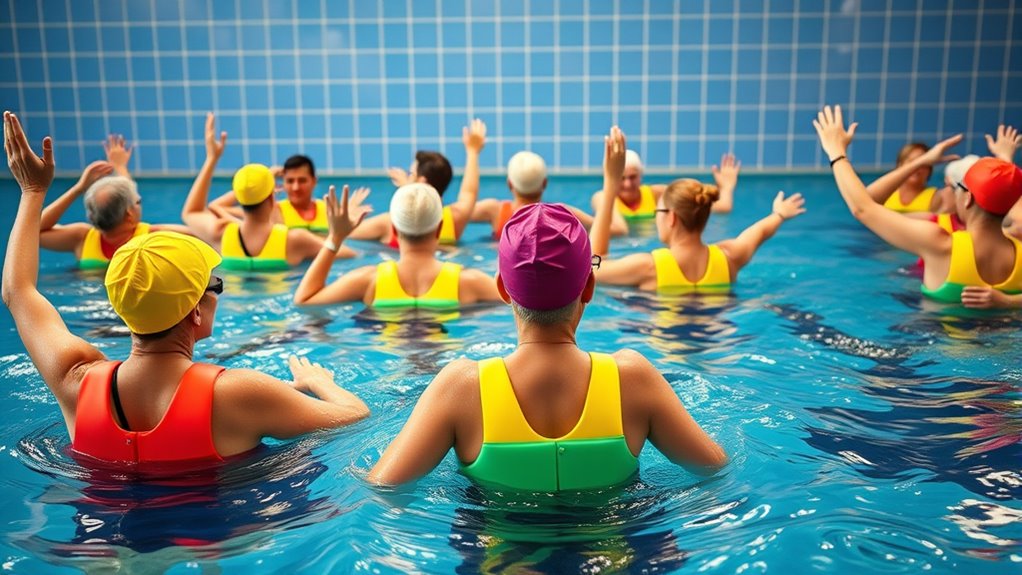Water aerobics offers a low-impact workout that’s gentle on your joints while providing effective full-body exercise. The water’s buoyancy reduces stress on your joints, and resistance helps build strength and endurance. You can customize routines with various equipment and adapt exercises for all fitness levels, making it safe and accessible. To discover how to make the most of this enjoyable, gentle exercise, keep exploring ways to improve your water aerobics experience.
Key Takeaways
- Water aerobics reduces joint impact by up to 90% due to water’s buoyancy, making it ideal for low-impact exercise.
- The natural resistance of water enhances muscle engagement without high-impact stress.
- Exercises can be modified with equipment like flotation devices and resistance tools to ensure safety and accessibility.
- Water temperature and environment are controlled to optimize comfort and prevent injuries during workouts.
- It offers cardiovascular, strength, and flexibility benefits while minimizing joint strain, suitable for seniors and those with joint issues.
What Is Water Aerobics and How It Works
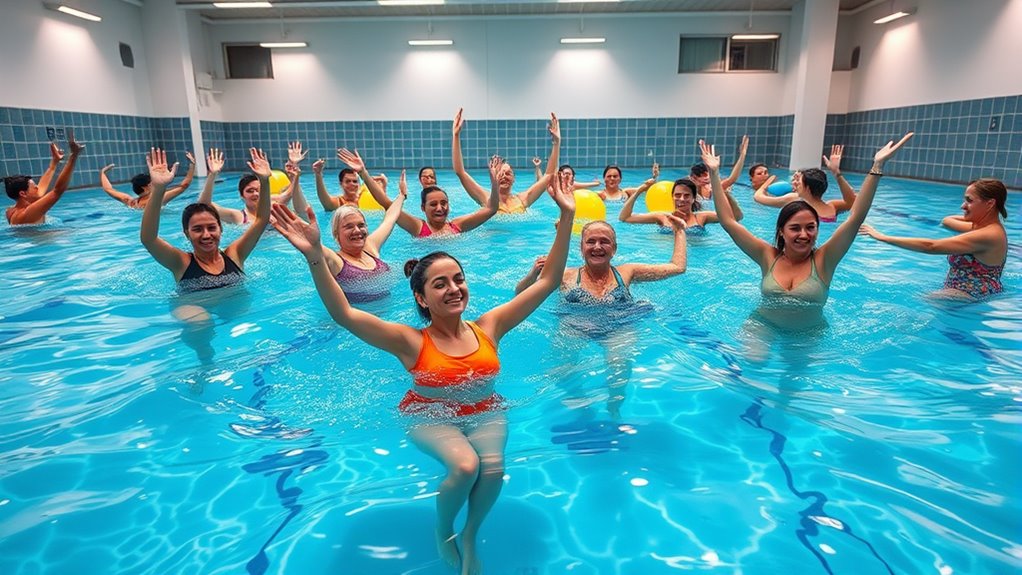
Have you ever wondered how water aerobics provides a full-body workout without stressing your joints? It’s all thanks to water’s unique properties. Buoyancy lifts your body, reducing impact and joint stress, making movements easier and safer. Additionally, the analytical thinking involved in designing water aerobics routines ensures exercises are both effective and safe for participants of all fitness levels. As you exercise, the resistance from water—about 12 times greater than air—adds challenge without risking injury. This natural resistance helps strengthen muscles, improve flexibility, and boost cardiovascular health. Furthermore, the hydrostatic pressure exerted by water can aid in reducing swelling and promoting circulation during workout sessions. During a typical class, you’ll go through warm-up, cardio, strength, and cool-down phases, often to motivating music. Exercises are mainly in shallow water, but modifications exist for deeper water or different fitness levels, using equipment like water weights or kickboards. The therapeutic benefits of water can also enhance recovery and reduce pain for those with chronic conditions. Incorporating mind-body connection techniques can further amplify the benefits of water exercise, promoting relaxation and mental clarity. Water’s buoyancy and resistance work together to create an effective, low-impact workout for everyone.
The Benefits of Participating in Water Aerobics
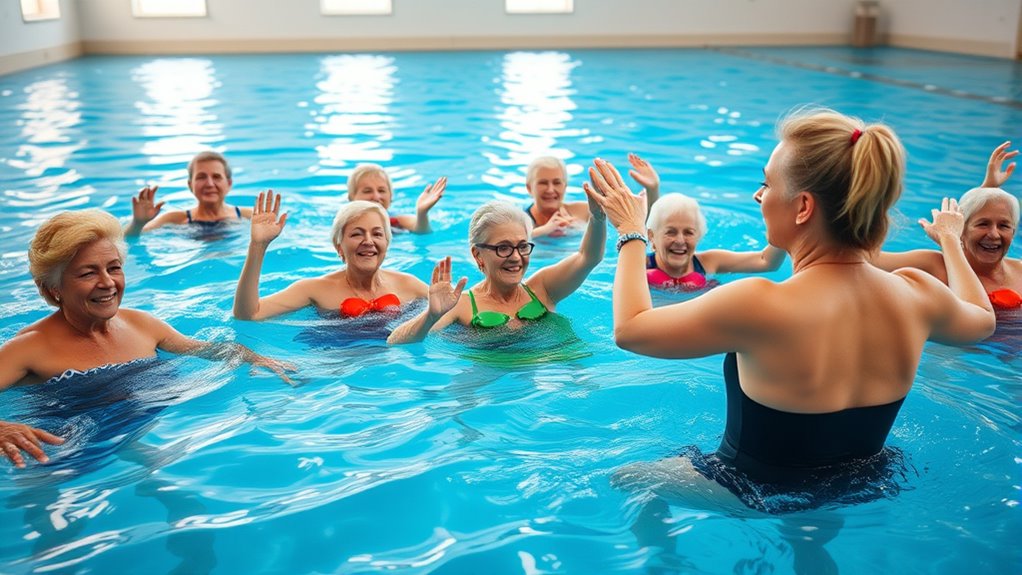
Participating in water aerobics offers a wide range of health benefits, making it an excellent choice for people of all fitness levels. This low-impact exercise reduces joint stress thanks to buoyancy, allowing you to move freely without strain. The water’s resistance makes each movement more effective, supporting calorie burning and body toning without high-impact impacts. Using equipment like water weights or kickboards can further target specific muscles and increase workout difficulty. Water aerobics is especially beneficial if you have joint problems, injuries, or chronic pain, providing a safe environment to stay active and improve overall fitness while minimizing joint stress. Incorporating water exercises can also promote mental well-being by reducing stress and enhancing mood through the calming effects of water mindfulness practices. Additionally, these exercises often utilize home heating solutions to maintain a comfortable environment, making sessions more enjoyable and accessible. Proper water temperature is essential for maximizing comfort and safety during workouts, ensuring that participants remain relaxed and prevent muscle stiffness. Furthermore, selecting the right projector technology can enhance the visual experience during your workout or relaxation time at home.
Essential Equipment for Water Aerobic Workouts
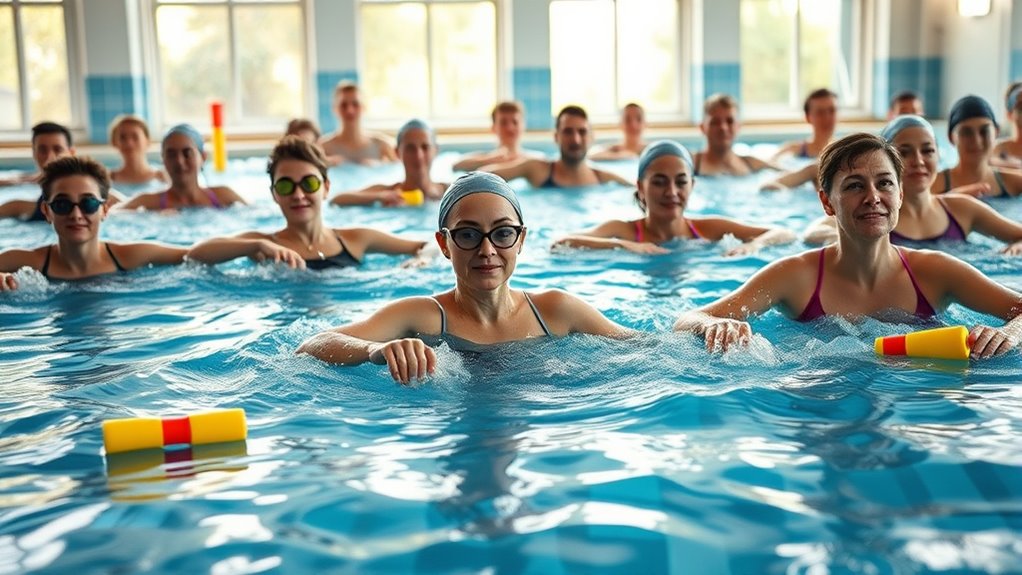
To get the most out of your water aerobics sessions, you’ll want to use the right equipment. Resistance tools like dumbbells, gloves, and paddles boost workout intensity.
Buoyancy aids such as kickboards and foam barbells support proper form.
Selecting the appropriate weights and supports helps target muscles effectively and keeps your workout safe and enjoyable.
Resistance Tools and Weights
Using resistance tools and weights in water aerobics enhances your workout by adding extra load and challenging your muscles more effectively. These tools, like water weights, foam barbells, and resistance gloves, increase workout intensity and promote muscle engagement without high-impact stress.
Equipment such as pool noodles, resistance bands, and ankle or wrist weights help target specific muscle groups and boost strength training. Proper use and selection of resistance tools allow you to customize exercises, accommodating various fitness levels and rehabilitation needs.
Leveraging water’s natural 12 times greater resistance maximizes calorie burn and muscular endurance. Incorporating these tools not only improves muscle strength but also makes your water aerobics sessions more dynamic and effective.
- Water weights for added resistance
- Foam barbells for upper body strength
- Resistance gloves for enhanced muscle engagement
- Ankle and wrist weights for targeted training
- Resistance bands for customizable workouts
Buoyancy Aids and Supports
Incorporating buoyancy aids and supports into your water aerobics routine can substantially enhance your workout experience. Buoyancy aids, like flotation vests and noodles, help support your body weight, which reduces joint pressure and makes movements easier on your joints. These supports are especially helpful for beginners or those with joint concerns, providing stability and balance during exercises. Using gelato-like textures or similar materials can also improve comfort and grip during exercises. Water weights and foam barbells add resistance, boosting muscle engagement without added impact. Ankle and wrist weights increase water resistance, allowing targeted strength training while maintaining a low-impact approach. Proper use of buoyancy aids ensures your safety and allows you to modify exercises to match your skill level and physical needs, making your water aerobics session both effective and comfortable. Additionally, selecting the right support equipment can help prevent injuries and encourage consistent participation in your workouts. Incorporating proper technique and equipment can also enhance safety and maximize benefits from your routine.
Effective Water Aerobics Exercises for All Fitness Levels
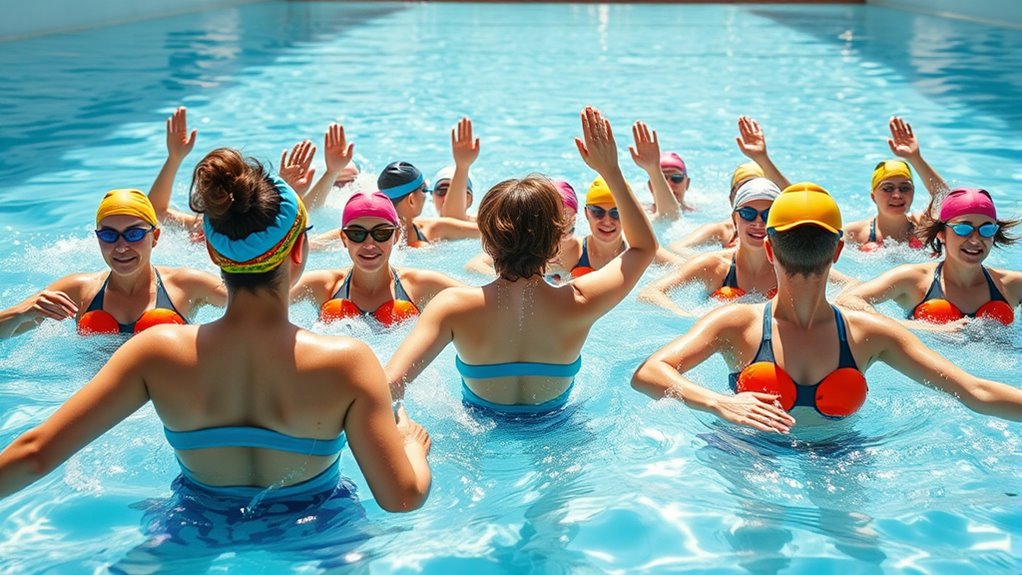
Water aerobics exercises can be easily adapted to suit all fitness levels by adjusting repetitions, speed, and resistance tools. Whether you’re a beginner or more advanced, you can modify the intensity to match your needs. Use equipment like water dumbbells, resistance gloves, or pool noodles to increase challenge or simplify movements for joint safety. For a low-impact exercise, try grounded step-touches or gentle leg lifts, making sure you remain comfortable. Incorporating mindfulness into your water aerobics routine can also enhance mental well-being and promote relaxation during exercise. Employing proper technique ensures safety and maximizes the benefits of each movement. To progress, add more repetitions, incorporate complex movements, or try interval training within your water aerobics routine. This flexibility allows you to build strength, improve cardiovascular health, and increase flexibility safely. Remember that water resistance naturally intensifies workouts, allowing for effective training without added strain. Additionally, paying attention to individual fitness levels helps tailor the workout to prevent overexertion and injury. Adjusting your workout to include appropriate equipment can further enhance safety and effectiveness. Enjoy the benefits of a low-impact water aerobics workout tailored precisely to your fitness stage.
Tailoring Water Aerobics for Seniors and Special Populations

Have you ever wondered how water aerobics can be safely adapted for seniors and individuals with special needs? The key is focusing on low-impact adaptation techniques that make exercises accessible and safe.
For seniors, modifications like slower tempos, shorter sessions, and flotation devices help reduce joint stress and prevent injury. These adaptations allow participants to enjoy the benefits of improved flexibility, balance, and muscle strength while minimizing risk.
Whether in shallow or deep water, the buoyancy offers significant joint relief—up to 90%—making even those with joint issues or recovering from injury comfortable.
Professional instructors trained in adaptive aquatic fitness can tailor routines to each individual’s ability, ensuring everyone benefits from a safe, effective, and enjoyable low-impact workout.
Enhancing Your Routine With Pool Exercises and Resistance Training
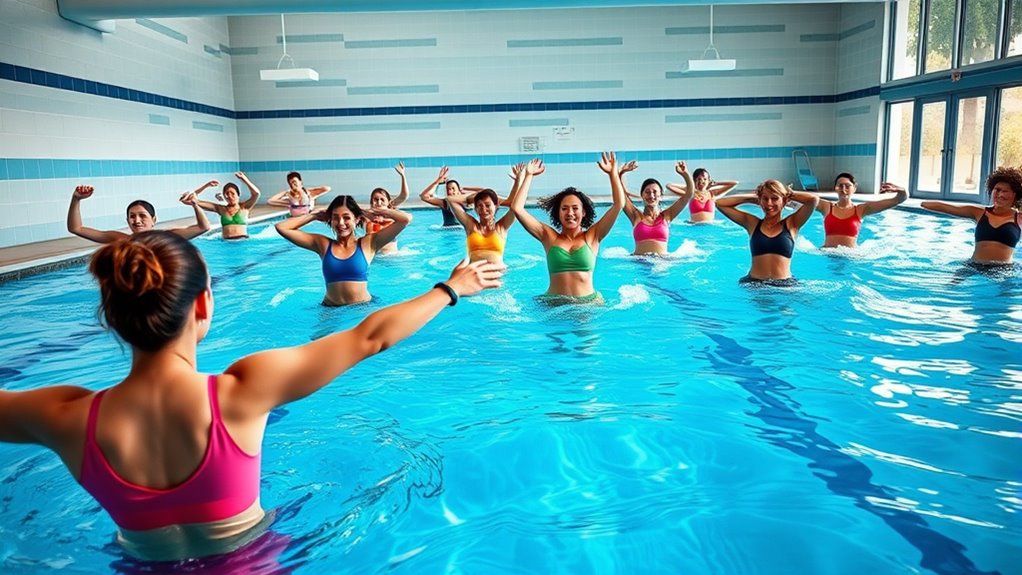
Enhancing your water aerobics routine with pool exercises and resistance training can substantially boost muscle engagement and overall effectiveness. By incorporating water resistance, you activate more muscles and improve strength without high-impact stress. Water resistance is a key factor that increases workout intensity naturally and safely.
Use pool exercises like flutter kicks, squats, and scissor kicks to target core, legs, and hips. Resistance tools such as water dumbbells, resistance gloves, and pool noodles add intensity and allow for personalized resistance training. Incorporating water resistance benefits can lead to more efficient workouts with less joint impact. Additionally, understanding how coolers are airtight can help you maintain optimal water temperature for comfort and safety during your exercises.
Performing upper body movements like bicep curls, tricep extensions, and chest presses in chest-deep water maximizes toning with minimal joint strain. Engaging multiple muscle groups through resistance training can enhance strength and endurance over time. Using proper technique during exercises ensures safety and maximizes the effectiveness of your workout.
Incorporating circuit-style resistance training with repeated pool exercises can burn calories and build muscular endurance. Proper use of resistance equipment and controlled movements ensure safety and maximize your workout benefits.
Key Considerations for Safe and Enjoyable Water Aerobic Sessions
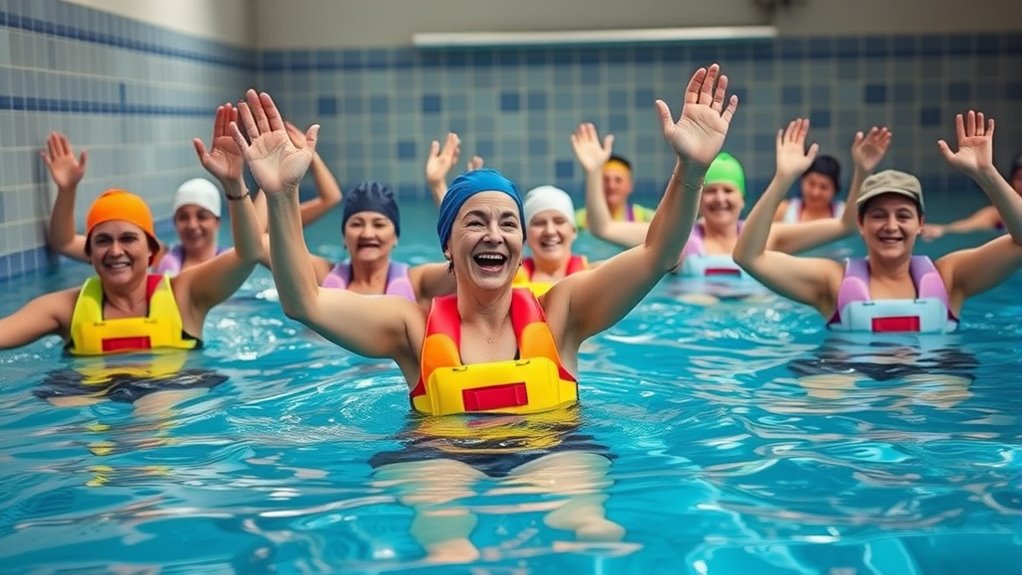
To guarantee you get the most out of your water aerobics sessions while staying safe, paying attention to key considerations is essential. When doing water exercises, maintain water temperature between 83°F and 86°F to stay comfortable and promote flexibility. Use proper equipment, like resistance weights and kickboards, correctly to prevent injuries and maximize the benefits of your low-impact workout. Adjust exercises by modifying repetitions, speed, or equipment to match your fitness level and avoid overexertion. Be mindful of water depth, as impact increases in waist-deep water, affecting joint safety. Always listen to your body and consult a healthcare professional if you have pre-existing conditions. Incorporating proper hydration during and after workouts can help maintain energy and prevent dehydration. Additionally, understanding water safety guidelines is crucial to ensure a secure environment during your sessions. Regularly monitoring indoor air quality in your workout area can help prevent discomfort and respiratory issues, especially in enclosed pools or gyms. Maintaining air purifier filters and ensuring proper ventilation can enhance air quality, reducing the risk of respiratory irritation during indoor workouts. Prioritizing exercise modifications and safety measures ensures your sessions are both enjoyable and injury-free.
Frequently Asked Questions
Is Water Aerobics Low-Impact?
You might wonder if water aerobics is gentle on your joints. The answer is yes. Water’s buoyancy supports up to 90% of your body weight, reducing joint stress.
The resistance of water helps you exercise effectively without harsh impact. Movements are slow and controlled, lowering injury risk.
If you have joint issues or are recovering from injury, water aerobics offers a safe, low-impact way to stay active and improve your fitness.
What Are the Disadvantages of Water Aerobics?
Like a gentle tide, water aerobics has its drawbacks. You might find it less intense for building high muscle strength or stamina, especially if you’re an advanced athlete.
Accessing pools and equipment can be costly and tricky to coordinate.
Plus, water resistance can slow your workout tempo, making it feel less challenging.
Proper technique is essential, or you risk injury, and temperature fluctuations could affect your comfort and safety.
How Many Times a Week Should You Do Water Aerobics?
You should aim to do water aerobics at least 2 to 3 times a week for ideal health benefits.
If you’re a beginner, start with 1 or 2 sessions and gradually increase as you feel more comfortable.
For noticeable improvements in strength, flexibility, and cardiovascular health, sticking to 3 sessions weekly is perfect.
Adjust the frequency based on your fitness goals and how your body responds.
Is Water Aerobics Better Than Walking?
Thinking about whether water aerobics is better than walking is like choosing between a multi-tool and a simple knife. Water aerobics offers a complete-body workout, burns more calories, and reduces joint impact, making it ideal if you’re looking for variety and lower risk.
Walking mainly targets your lower body. So, if you want an all-encompassing, low-impact exercise, water aerobics could be the better choice for you.
Conclusion
Water aerobics offers a low-impact, effective way to stay active, with over 70% of participants reporting improved mobility and reduced joint pain. By incorporating these exercises into your routine, you can enjoy better cardiovascular health and increased flexibility without stressing your joints. Remember to prioritize safety and choose exercises suited to your fitness level. Immerse yourself in water aerobics and experience the benefits for yourself—it’s a fun, accessible way to boost your overall well-being.
